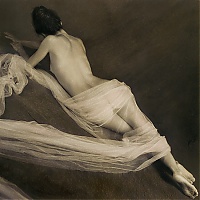.

Aphrodite, 2003
Brigitte Carnochan's Statement
Despite the debates over "honesty" and "truth" in photography, it is an intrinsically subjective art and form of communication. The photographer has chosen, from a huge range of images, certain ones - or pieces - from a certain perspective, with the light at a certain angle and at a unique moment in time. And the "story" in the photograph begins with the photographer's decision of when to click the shutter and isn't completed until each viewer interprets that image in his or her own way.
The qualities that have fascinated me and led me to make a particular photograph are usually quite intuitive. I generally don't have a completed concept in my mind when I begin--I move things around, change angles, lighting--until everything seems right. To further complicate issues of "truth," I often add color to a black and white image in order to bring out, most convincingly, the impression it has made on me--and I have no concern about whether the colors are the "real" colors.
In documentary photography the same subjective issues apply--but realizing and recording the "right" moment requires quicker reflexes and a different kind of intuition. Sensing a moment coming by keenly observing the scene--and always being ready for that moment--is the excitement in that kind of photography.
All of my images begin as straight gelatin silver prints, but in my nudes and floral still lifes, I am often drawn to hand coloring on several counts.
First in literature and now in photography, I have been interested in the power of the imagination--how it colors everyday life - creates, in fact, private views of experience, whether revealed in words or in images.
Even though most people see the world in color, they do not see everything in the same exact colors. From an optical point of view, the colors we see depend on where we stand in relation to the object, where the sun is on the horizon, what color the walls are, or the tint of our glasses (or contact lenses), and so on. From a psychological point of view--everything depends on whether we are worried, elated, anxious, in love, lonely, distracted, or fully alert. For this reason, I often hand color my work, because the process allows me to interpret the essence of my subject according to my own imagination.
Whether it is nudes and flowers or the black and white images in my series from Cuba, Africa, or Mexico, imagination colors--literally and figuratively--not only what I see initially, but what the viewer sees, ultimately. And seeing, of course, is everything in photography: seeing--and light and shadow.
REGRESAR A LA REVISTA








.jpg)



